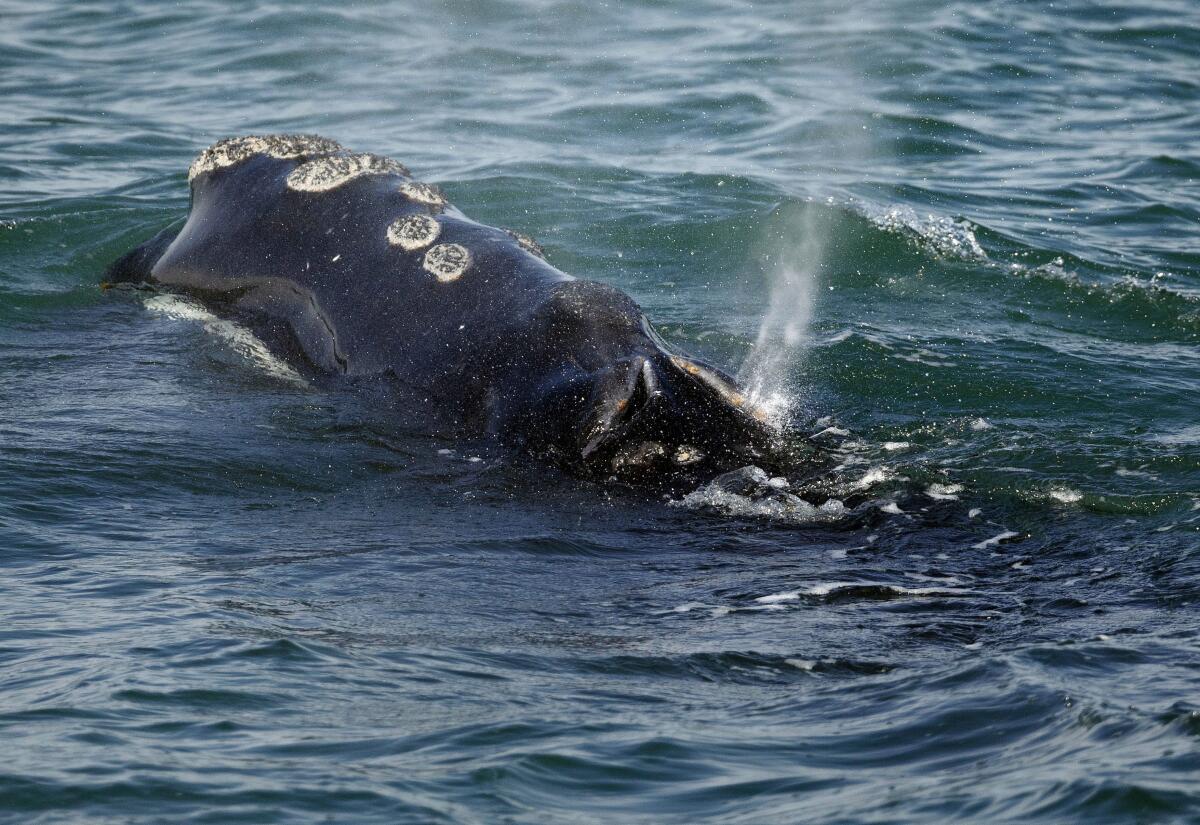Opinion: Oceans are heating up. Who will protect the turtles, whales and fish crossing borders into cooler waters?

- Share via
It’s been a hot summer. The ocean has been hot too. Marine heat waves, or patches of warmer-than-normal sea surface temperatures, are making headlines because we’ve never seen anything quite like what’s going on in the ocean right now.
These heat waves will cause marine species to disappear in some areas and appear in others. Previous scientific research found that mobile marine species — including tuna, penguins and sharks — will shift toward the poles during heat wave events. But a new study published this week shows a much more complicated story of how mobile animals respond to marine heat waves and the costs and responsibilities this movement will carry for countries receiving these species.
An influx of leatherback turtles into a country’s waters may require shutting down or relocating fisheries to avoid entanglement in fishing gear; an influx of blue whales could necessitate speed reductions for cargo vessels to avoid ships striking the animals. When valuable species such as tunas cross borders, the influx nation may need to increase processing plant capacity, while the outflow nation may need to compensate their fishermen for lost revenue.
I dived to the ocean’s deepest point. I’ve seen how crucial it is to map every corner of our warming planet.
Waters around the world are seeing these elevated temperatures. A record-breaking marine heat wave is occurring in the North Atlantic, producing the warmest waters seen in the last 170 years. In the Gulf of Mexico, water temperatures off the coast of Florida have surpassed 100 degrees; off Baja California, an unprecedentedly warm ocean generated the first tropical storm to hit Los Angeles in 84 years. Normally, around 10% of the ocean surface is expected to be in a marine heat wave state, but the latest forecast predicts that up to 50% of the ocean surface will experience marine heat wave conditions by this fall.
For the report, my colleagues and I studied the effect of four major marine heat waves from recent years on 14 mobile marine species in the Northeast Pacific (bounded by Alaska, Hawaii and the West Coast of North America). We found evidence of species shifting their habitats in all four cardinal directions.
For example, bluefin tuna habitat relocated about 375 miles north along the coast of California during a 2015 heat wave, but shifted about 110 miles south during the 2019 heat wave. Endangered leatherback turtle habitat shifted about 55 miles to the west during a 2014 heat wave and nearly 250 miles to the northeast in 2019.
Your climate-change resource guide includes opportunities for education, volunteering and activism — with something for nature lovers, people fighting food waste and more.
Other ocean properties important to marine life, such as chlorophyll found in algae that some animals feed on, and oxygen concentration that can affect animals’ metabolic rates, varied among heat waves too. These physical differences translated to ecological differences: Each heat wave had distinct effects on species habitats, even when the heat waves occurred in the same area of the ocean.
These marine heat waves often moved species habitats across geopolitical borders. During one heat wave, albacore tuna habitat shifted into U.S. waters from Mexican waters. When one country’s fish ends up in another country’s waters, it may cause commercial conflict. About a decade ago, there was the Northeast Atlantic mackerel war when warming waters shifted mackerel into Icelandic waters, leading to tensions with European nations over fishing quotas.
Meanwhile, endangered species shifting across borders are exposed to new threats. North Atlantic right whales are moving away from warming waters in the Gulf of Maine and into the cooler waters of the Gulf of St. Lawrence in Canada, where they face increasing risk of ship strike and entanglement in fishing gear.
Countries will need flexible management to respond to influxes or outflows of species from their waters. Although the changing locations of marine species can now be tracked in real time during marine heat waves, adjusting management plans — such as relocating fishing grounds or increasing fish processing capacity — requires advanced warning to organize and implement.
Forecasts are readily available for physical phenomena such as weather and floods. But forecasts for ecological phenomena, such as where species will go in the near future, are still in their infancy, though they are becoming more common. In fact, forecasts of changing lobster distributions during heat waves are already used in the Gulf of Maine to support the lobster fishery.
The sea is rising higher and faster — California could see a jump of more than 9 feet by the end of the century. Flooding and erosion threaten homes. Beaches could vanish. But everyone insists: This is a game that can be won.
We’ll soon need more ecological forecasts for other ocean regions. A large marine heat wave is currently forming in the Northeastern Pacific and El Niño conditions were declared in June. This year is setting up to look a lot like 2015, when a record-breaking mass of warm water emerged in the Northeast Pacific, which caused cod to disappear from Alaskan waters, an increase in humpback whale entanglements in fishing gear and the largest mass seabird die-off in recorded history.
We don’t know yet whether this year’s heat wave will be as severe for marine species as the one in 2015. But the need to develop timely responses to heat waves and species on the move will become ever more crucial as our climate continues to change.
Heather Welch is a marine spatial ecologist at UC Santa Cruz who develops climate-ready tools to manage biodiversity and fisheries.
More to Read
A cure for the common opinion
Get thought-provoking perspectives with our weekly newsletter.
You may occasionally receive promotional content from the Los Angeles Times.













